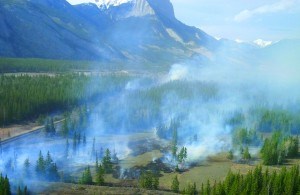
An errant spark off a CN Rail line created a five-hectare wildfire in the east end of the park, April 27, burning grass and a few trees south of Snake Indian River, across the valley from Highway 16.
“[CN] was doing some work on the tracks and a spark was produced from that,” explained Kim Weir, fire communications officer for Jasper National Park. “It happens. But with the springtime, the grasses can dry out so quickly—especially out there because it's such a windy area, so the fine fuels can get dry in a blink of an eye.”
Weir said because of recent rainfall, the fire was contained to those fine fuels along the tracks, but noted that it also spread into a nearby meadow.
“In most spots it was only about 30 metres wide and 750 metres long, but then when you incorporate that meadow it added up to about five hectares,” she said.
To fight the blaze, five members of the JNP fire crew responded on the ground, along with two helicopters bucketing water from the air.
The fire was contained on April 27, but the crew was still in the area with a helicopter the following day, ensuring it was fully extinguished.
“It's in a gnarly area and it's going to take some time to mop up, just because the perimeter is quite large and it's burned deep into some areas,” said Weir on April 28, noting that the crew and a helicopter would be in the area again on April 29 to continue work on a deep ash pit.
This marks the first wildfire of the season. Weir noted that there was low fire danger at the time, but the blaze was able to pick up rather quickly because of strong winds in the area.
With fire season now in full swing, Weir urged park users to be careful with all sources of flame.
“That means putting your cigarettes away in the proper receptacle, and a big one is having your campfires in proper fire pits or fire grates.”
She said that people often don't understand that a fire lit directly on the ground can result in a serious wildfire, even if it seems to be extinguished.
“That fire has definite potential to burn down deep into the flammable layer under the ground and then keep burning until conditions are right for it to become a wildfire,” she said, noting that in a national park it is illegal to light a fire outside of a designated pit.
Nicole Veerman
[email protected]
